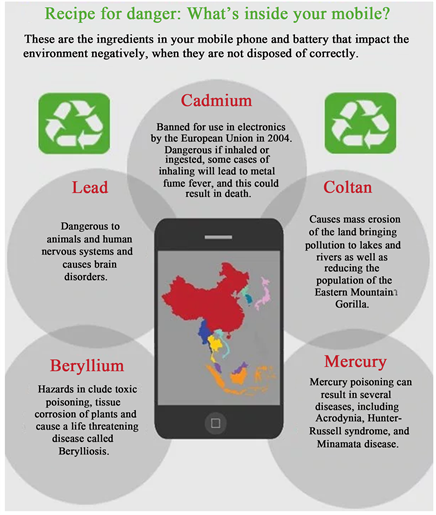In the previous post, I discussed how the advancement of technology in mobile phones has helped mankind predict, know and take action regarding air pollution and its associated effects. However, we ought to take a step back and think about the environmental cost of the very gadget that has now become irreplaceable in the lives of 6 billion people worldwide.
According to findings published in the 2018 Journal of Cleaner Production, information and communications technology (ICT) will account for 14% of global emissions by 2040. Extensive research has been conducted to analyse the impacts smartphones leave on the environment, but little has been done to address the issue. A smartphone is the most damaging ICT device as it contributes to global emissions throughout the entirety of its lifecycle – from manufacturing to usage to disposal.
Fig 1 shows the breakdown of the amount of greenhouse gas emitted at each stage of a cell phone’s lifecycle, based on the iPhone 8.

Fig 1: Greenhouse Gas emissions of a smartphone (Source: Graham, 2021)
Approximately 85% of each device’s carbon footprint comes from the manufacturing stage. The extraction of scarce resources and raw materials such as cobalt, lithium and other heavy metals (Fig 2) are not only subjected to energy-intensive mining processes, but also releases toxic chemicals and pollutants that have a long residence time in the atmosphere. The production of most phones requires 16 out of the 17 rare earth elements, which can be immensely inimical to both the health of the environment and humans. Furthermore, post-manufacturing activities like transportation and shipping across the globe also drive carbon emissions upwards.

Fig 2: Mobile phones contain a ton of harmful heavy metals (Source: Mani, 2019)
The environmental costs of smartphones unfortunately do not end with the production of hardware. Our usage of mobile phones also plays a part in raking up carbon footprints; which is particularly worse since the effects of our actions are largely invisible. Every text message sent, phone call made and video downloaded necessitates energy consumption from telecommunication networks and data centers. Research reveals that one hour of mobile usage a day can produce 63 kilograms of CO2 emissions, thus drastically contributing to pollution when the effect is multiplied across billions of people worldwide.
The life span of a phone isn’t long either, thanks to telecommunication companies encouraging clients to switch or upgrade phones every few years when their contract expires. Disposal of these gadgets creates a progressively large mountain of e-waste. The annual volume of global e-waste is projected to reach 74 million tonnes per year by 2030. Moreover, mercury and cyanide by-products from discarded cell phones will leach into groundwater in landfills, leading to contamination of water bodies.

Following the progress of societies, the development of technology and ICT are intended to ameliorate air and other sources of pollution. In reality, these devices are a double-edged sword that also has numerous unintended implications for our environment. As much as they solve certain issues like predicting air quality, consumption and production of mobile phones inevitably create other – perhaps more severe – consequences.
Bibliography
Belkhir, L., & Elmeligi, A. (2018). Assessing ICT global emissions footprint: Trends to 2040 & recommendations. Journal of Cleaner Production, 177: 448-463.
Gill, V. (2022, October 14). E-waste: Five billion phones to be thrown away in 2022. Retrieved from BBC News: https://www.bbc.com/news/science-environment-63245150
Graham, E. (2021, May 7). What is the Carbon Footprint of a Smartphone? Retrieved from S2S Group: https://s2s.uk.com/news/general/what-is-the-carbon-footprint-of-a-smartphone/
Mani, R. (2019). Do Mobile Phones Cause More Harm than Good? Open Journal of Social Sciences, 7(8): 198-205.
Martin, B. (2020, February 24). The Hidden Environmental Toll of Smartphones. Retrieved from Open Mind BBVA: https://www.bbvaopenmind.com/en/science/environment/the-hidden-environmental-toll-of-smartphones/
McMaster University. (2018, February 28). Study shows smartphones harm the environment. Retrieved from McMaster University: https://www.eng.mcmaster.ca/news/study-shows-smartphones-harm-environment#:~:text=While%20smartphones%20consume%20little%20energy,mined%20at%20a%20high%20cost.

Leave a Reply